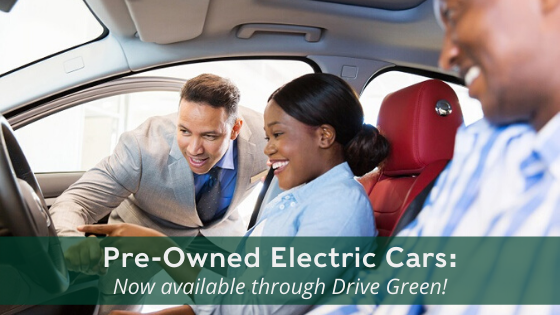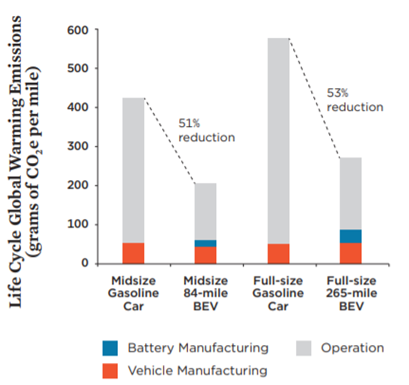Webinar Recap: Buying a Pre-Owned Electric Car

Electric vehicles (EVs) are more affordable than ever thanks to advances in battery technology. The availability of pre-owned EVs also makes driving on electricity accessible to consumers with any budget. Green Energy Consumers hosted a webinar on March 25 to give advice on how to purchase a pre-owned electric car. You can watch the full webinar & read a summary here.
Why buy a pre-owned electric vehicle?
No manufacturing emissions
Because EV batteries require energy-intensive materials, manufacturing an electric car releases more climate-warming emissions than manufacturing a gas-powered car. However, over the life of the vehicle, the additional emissions are offset because EVs are cleaner to run per mile, leading to a 53% reduction of emissions overall.

The Union of Concerned Scientists' report on lifetime emissions from EVs, Cleaner Cars from Cradle to Grave, confirms that electric cars are cleaner than gas-powered cars on both a per-mile and lifetime basis.
With a pre-owned EV, emissions have already been invested to produce it, so driving that car until the end of its useful life is the greenest way to drive. Choosing to drive a pre-owned electric car can reduce your overall carbon footprint by more than a third compared to buying a new electric car.
Keep in mind – EVs make up only 2% of vehicle purchases in the United States. Buying a new electric vehicle is still a net good for the environment. even when compared to a pre-owned gas-powered car. You can explore both new and pre-owned options with Drive Green to find the right car for you.
Great car for the price
Electric vehicle technology has come a long way since the first mass-market EVs became available in 2012. Most new EVs have over 200 miles of all-electric range, but many of the vehicles available to buy pre-owned have about 80-150 miles of range. The limited range of EVs from 2017 or earlier drives down resale values because the current technology is significantly better. Buyers can find great prices for EVs that are gently-used, low-mileage, or off-lease.
Extremely cold temperatures can drive down range even more in the winter, so you may want to take this into account when choosing a low-range pre-owned EV. Learn more here.
Good options for many lifestyles and budgets
There are many drivers for whom the limited range of a pre-owned EV is workable, including retired folks who only drive around town, two-car households, and families with teenage drivers. Since electric vehicles are inexpensive to maintain and fuel, a pre-owned model is ideal for anyone who wants to own a car with as few costs as possible.

Battery health and warranties
Battery health is a common concern for drivers who are considering switching to an electric vehicle, but EV batteries hold up well. Battery condition is measured according to State of Health, starting at 100% and deteriorating naturally over time, as a measure of how much energy the battery can store compared to itself when it was new.

According to data from 6,000 vehicles of various makes, models, and years, the battery packs in EVs lose an average of 2.3% of capacity for every year on the road. You can compare specific EV models using Geotab's EV Battery Degradation Tool Comparison Tool.
2.3% yearly range loss is barely noticeable and slow enough to ensure the battery will outlast the life of the car. However, the average rate of degradation varies depending on the model and year of the car.
Even though the battery itself can be complex, electric power trains are much simpler than internal combustion engines. Gasoline-powered engines have as many as 400 moving parts, whereas electric motors have as little as 20 moving parts. The simplicity of electric motors is the reason why drivers can expect to save $1,500 in maintenance costs over five years and why EVs are more reliable cars than gas cars, especially when purchased pre-owned.
In addition to their reliability, electric vehicles come with good warranty policies. While the basic coverage warranty can end in as little as three years, most battery warranties protect the driver for eight years or 100,000 miles.
| Electric Vehicle | Coverage | Percentage Guarantee |
| Nissan LEAF |
8 years / 100,000 miles |
Below "9 bars" ~70% |
| Chevrolet Bolt |
8 years / 100,000 miles |
60% |
| Tesla | unlimited | |
| Volkswagen e-Golf |
8 years / 100,000 miles |
70% |
| BMW i3 |
8 years / 100,000 miles |
70% |
This coverage should extend to any secondhand vehicle owner (and be sure to read the fine print under the warranty information to make sure that it does.) In the very unlikely event that a battery fails outright, it is not a cost that the owner will have to bear. Further, many manufacturers cover capacity loss up to a certain percent within the warranty period to protect from unexpectedly high rates of degradation.
Tips for buying pre-owned
- There are dozens of available electric models to buy pre-owned. Determine your budget and desired electric range to help narrow the field. The older a vehicle is, the less expensive it will be, but the lower driving range it will have.
- Different model years of the same vehicle can vary widely in electric range. Make sure you confirm the electric range of the particular vehicle you’re interested in.
 The 2016/2017 model years of the Nissan LEAF, the BMW i3, and the Volkswagen e-Golf are some of the most popular electric vehicles to buy pre-owned.
The 2016/2017 model years of the Nissan LEAF, the BMW i3, and the Volkswagen e-Golf are some of the most popular electric vehicles to buy pre-owned.
- Take a long test drive to help you decide between models with similar electric range and price. Test driving is also a good opportunity to check that the vehicle has proper heat and air conditioning, good tires, and a working audio/entertainment system, among other things. Learn more here.
- Investigate the car’s history to make sure the battery health of the particular vehicle is about what you would expect for the age of the car. The Nissan LEAF has a battery health bar display right on the dashboard, which makes it easy to see when you’re test drive. For other vehicles, a reputable seller of EVs should be able to tell you the battery’s exact State of Health by plugging a diagnostics device into the car’s computer.
Other common questions
Q: Where do you go to service an EV?
A: The only regular maintenance that EVs need are tire rotations and changing air filters in the HVAC system. Any business qualified to perform these services on a gas-powered car should be able to service your electric vehicle as well.
Q: How do insurance rates compare to gas vehicles?
A: Insurance rates don't vary between gas and electric cars.
Q: Are there pre-owned electric SUVs available?
A: The heavier a vehicle is, the less efficient it is and the less electric range it has. Early EVs were mostly sedans and compact cars to maximize their electric range. Technology has advanced such that automakers are manufacturing larger electric vehicles, but these models are very new (2019 and 2020 model years). Consumers are unlikely to find them on the pre-owned market at this time.
Q: Are there any tax incentives for pre-owned vehicles?
A: As of this writing, the federal tax credit and Massachusetts state rebate for EVs apply only to new vehicles.
Related Posts
Consumer Reports: Electric cars are cheaper... really!
A new report by Consumer Reports has found that the average electric vehicle (EV) driver saves between $6,000 and...


Comments